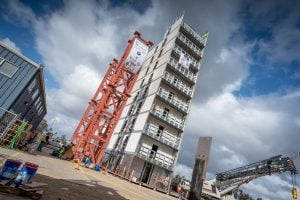
Johns Hopkins civil engineer Ben Schafer and collaborators are about to shake up conventional wisdom around building safety—literally. Over the course of June and July, they will subject a 10-story building to the full force of an earthquake and live fire at a national testing facility operated by the University of California, San Diego (UC San Diego).
The experiments are part of a broader effort to rethink how cold-formed steel buildings respond to natural disasters—both seismic and fire-related. Schafer is leading the earthquake effort alongside Tara Hutchinson of UC San Diego, while fellow Johns Hopkins engineer Thomas Gernay will oversee fire modeling to understand how post-quake fires impact already damaged buildings.
This multi-year project brings together Schafer, Gernay, Hutchinson, and a team of academic and industry engineers to challenge assumptions about cold-formed steel (CFS) as a construction material. Despite its strength and light weight, CFS is not generally considered for use in taller buildings—something the team plans to re-examine by testing the 10-story CFS building on UC San Diego’s shake table, the world’s largest outdoor earthquake simulator.
Part of the Natural Hazards Engineering Research Infrastructure network, or NHERI, the facility is operated by UC San Diego and funded by the U.S. National Science Foundation (NSF). Beyond NSF, additional project support is provided by the U.S. Department of Housing and Urban Development, the California Seismic Safety Commission, the California Office of Emergency Services, the National Institute of Standards and Technology, and a large array of industry participants.
“We’re asking how do we develop and validate entirely new building design concepts, even for the harshest of demands—earthquakes? The CFS10 project is a rare opportunity to generate real-world data to answer that question, which could fundamentally change how we design tall buildings, especially in earthquake-prone regions,” said Schafer.
During the three-week earthquake testing phase, the researchers will evaluate how the building, which at just under 104 feet exceeds current ASCE 7-22 design standards for CFS by four stories—responds to seismic activity.
This NSF-supported effort is the culmination of eight years of collaboration to redefine building codes and enhance seismic resilience for taller CFS structures. This summer’s testing will enable the team to generate benchmark data to accurately predict a full-scale building response following natural hazards, like earthquakes.
“Through years of work, we’ve developed an understanding of how to model key components of new CFS framing systems. We’ve used models and smaller-scale testing to determine if these systems can perform well in earthquakes, giving us confidence in our new solutions,” Schafer said. “Overall, if we can predict the precise performance of a new building system, we can share those predictions with engineers to improve building design and construction practices in the U.S.”
In addition to the structural aspects, the team will analyze the response of non-structural elements, specifically how various systems perform under seismic demands—whether doors still open, stairs still function, and essential systems like gas and sprinkler pipes stay operational. By predicting failure risks for both structural and non-structural components, the researchers hope to minimize the time it takes for a building to return to its intended use, reducing economic and social disruption.
The test building incorporates three prevalent construction methods, traditional stick-built framing, panelized wall framing, and completely 3D modular units, offering direct comparison in their seismic and fire response. While modular construction is faster and more sustainable, it presents challenges when transporting and lifting modules and requires novel detailing to meet current seismic design criteria. Schafer says this experiment could offer new data on how all three methods perform and influence future design and construction decisions.
After seismic testing, the building will undergo a second round of experiments: four live fire tests to simulate post-earthquake fire conditions. Gernay, who specializes in performance modeling, will lead efforts to analyze how fire affects CFS structures already damaged by earthquakes. The team anticipates that the results will help reduce post-disaster downtime, improve functional recovery, and better predict how fire and quake damage compound one another.
The results from CFS10 could have far-reaching implications—from revised building codes and industry practices to public safety, especially as communities look for faster, safer, and more sustainable ways to build in areas affected by natural disasters.
“We need high-performance, non-combustible, quick to construct, reliable, and resilient housing. This building system checks all these boxes, and our research could open the door for cold-formed steel to become a go-to solution for engineers to use around the country and the world,” said Schafer.
Interested in seeing the testing as it unfolds? Follow along with UC San Diego’s live cams.